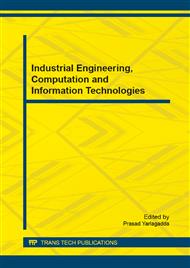[1]
M. Nyanchama, S. Osborn. Modeling Mandatory Services Certification in Role-Based Security Systems. IFIP Workshop on Database Security. Proceedings of the ninth annual IFIP TC11 WG11. 3 working conference on Database security IX: status and prospects: status and prospects, Rennselaerville, New York, United States, 2006: 129-144.
DOI: 10.1007/978-0-387-34932-9_9
Google Scholar
[2]
S. Osborn, R. Sandhu, Q. Nunawer. Configuring Role-Based Services Certification To Enforce Mandatory And Discretionary Services Certification Policies. ACM Transaction on Information and System Security, 2000, 3(2): 85-106.
DOI: 10.1145/354876.354878
Google Scholar
[3]
Li Qianmu, Zhan Guosheng, Hou Jun, Zhang Hong, Qi Yong. A Trusted Mobile Interaction in Ubiquitous Networks. International Journal of Advancements in Computing Technology. 4(15): 346-353, (2012).
Google Scholar
[4]
S. Osborn. Mandatory Services Certification and role-based Services Certification revisited. In: Proc. of the Second ACM Workshop on Role-based Services Certification. Fairfax, VA, 2007: 31-40.
Google Scholar
[5]
Qianmu Li, Jun Hou, Yong Qi, Hong Zhang. The Rule Engineer Model on the high-speed processing of Disaster Warning Information. Disaster Advances, 2012. 5(4): 432-437.
Google Scholar
[6]
Papazoglou M P.Service-Oriented Computing:Concepts,Characteristics and Directions.Fourth International Conference on Web Information Systems Engineering(WISE 03). Roma:2003. 12: 10-12.
Google Scholar
[7]
Li Qianmu. Mulitiple QoS Constraints Finding Paths Algorithm in TMN. Information, 2011. 14(3): 731-738.
Google Scholar
[8]
S. Demurjian. Implementation of Mandatory Services Certification in Role-based Security System. CSE367 Final Project Report. Computer Science & Engineering The University of Connecticut Storrs, CT 06269-3155. Fall (2007).
Google Scholar
[9]
Li Qianmu, Li Jia. Rough Outlier Detection Based Security Risk Analysis Methodology. China Communications, 2012. 5(7): 14-21.
Google Scholar
[10]
I. Mavridis, G. Pangalos, et al. eMEDAC: Role-based Services Certification Supporting Discretionary and Mandatory Features. In: Proc. of 13th IFIP WG 11. 3 Working Conference on Database Security, Seattle, Washington, USA, 2007: 63-78.
DOI: 10.1007/978-0-387-35508-5_5
Google Scholar


